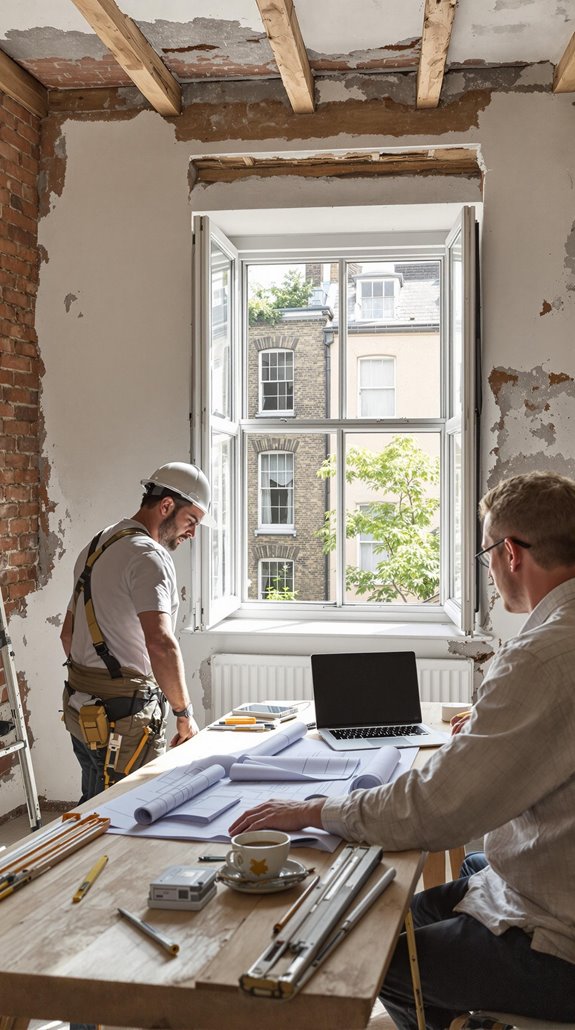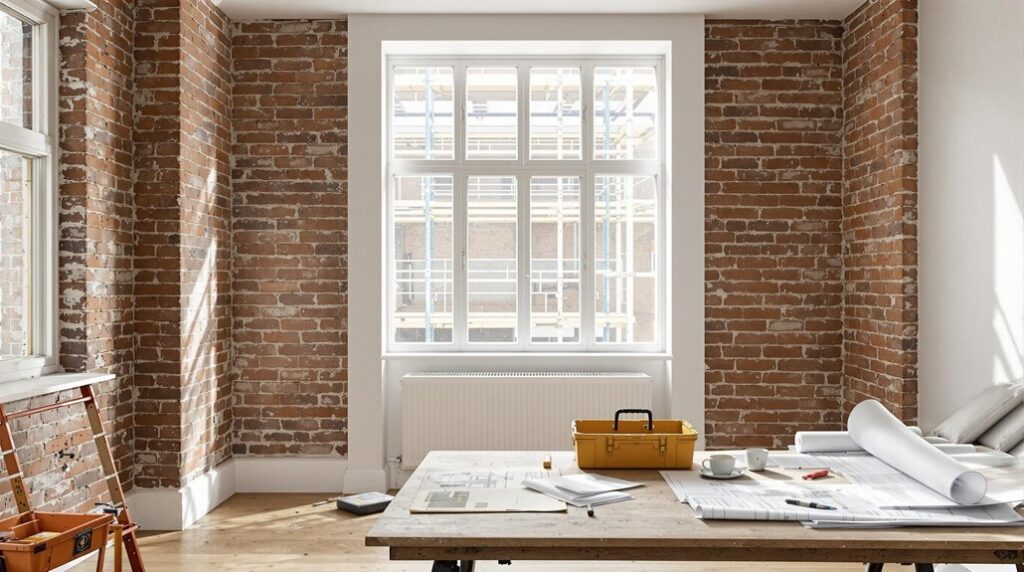I’ve learned the hard way that renovating a leasehold flat isn’t as simple as owning a freehold property. When I started my first flat renovation, I quickly discovered that your lease agreement holds significant power over what you can and can’t do to your home. Most leaseholders don’t realize they’re walking into a minefield of restrictions, fees, and legal requirements that could derail their entire project if they’re not properly prepared.
Key Takeaways
- Review your lease document carefully to identify alteration clauses and determine whether landlord consent is required for planned renovations.
- Obtain a Licence to Alter from the freeholder before starting structural work by submitting detailed architectural plans and contractor qualifications.
- Budget an additional 10-15% for mandatory freeholder fees, including surveyor assessments, legal costs, and building regulation certificates.
- Secure planning permission from local authorities, as leasehold properties typically lack permitted development rights for alterations.
- Unauthorised alterations risk lease forfeiture, legal action, voided insurance coverage, and potential property resale complications.
Understanding Lease Terms and Alteration Restrictions

Before you pick up a sledgehammer or start planning that open-concept kitchen, you’ll need to understand your lease’s alteration restrictions—they’re often more complex than most flat owners realize.
Your lease likely contains one of three covenant types. Absolute covenants ban all alterations without exception. Qualified covenants allow changes with landlord consent, which can’t be unreasonably withheld under the Landlord and Tenant Act 1927. Some leases explicitly prohibit structural modifications while permitting cosmetic updates.
The key challenge? Defining “structural” versus “non-structural” work varies by lease wording. Window replacements and plumbing modifications typically need approval due to potential structural impact. Structural alterations typically include changing layouts, removing walls, and replacing windows, while non-structural work involves cosmetic changes to fixtures and fittings. I’d recommend having a solicitor review your specific lease terms before proceeding—what’s permitted in one lease might be forbidden in another.
Securing Licence to Alter From Your Freeholder
Once you’ve confirmed your lease requires formal permission, you’ll need to secure a licence to alter from your freeholder—a legal document that grants explicit permission for your proposed renovations. I’ll submit a detailed proposal including architectural drawings, structural calculations, and proof of planning permission. The landlord’s surveyor will assess how my alterations impact the building’s integrity and other residents. If the freeholder is absent or unresponsive, it may complicate the process, but leaseholders can explore legal routes to address this issue.
After approval, their solicitor drafts the licence terms, which I’ll negotiate carefully. These typically include work hour restrictions, insurance requirements, and my obligation to cover the landlord’s legal fees. The licence may require property reinstatement to its original condition at the end of the lease. I must execute this licence as a deed before starting any work—this protects both parties and guarantees I won’t face enforcement actions or lease forfeiture for unauthorised modifications.
Managing Costs and Fees for Leasehold Alterations

The financial implications of securing leasehold alterations extend far beyond construction costs, with freeholder fees and administrative charges typically adding 10-15% to your renovation budget. I’ll help you navigate these unavoidable expenses systematically.
You’ll face several mandatory charges: surveyor fees ranging £200-£800 for plan reviews, administrative costs for License for Alterations processing, and legal fees averaging £500-£1,500 for solicitor work. Building regulation certificates add another £150-£300. Additionally, it’s crucial to understand that solicitor costs can vary significantly based on the complexity of the transaction, so careful budgeting is essential.
Don’t accept unreasonable charges without challenge. Under the Commonhold and Leasehold Reform Act 2002, all fees must meet reasonableness standards. If you’re facing excessive costs, you can dispute them through the First-tier Tribunal with proper documentation proving charges exceed market rates.
When planning your renovation budget, remember that London renovations typically cost 15% more than other UK regions, which applies to both construction work and associated professional fees for leasehold permissions.
Obtaining Planning Permission and Regulatory Approvals
While leasehold properties face additional regulatory hurdles compared to freehold renovations, understanding the planning permission and approval process will save you significant time and costly mistakes.
First, confirm whether your project requires planning permission by contacting your local planning authority. Leasehold properties typically lack permitted development rights, meaning most alterations need formal consent. This includes exterior changes, extensions, and structural modifications.
You’ll need to submit detailed applications showing your proposed work’s environmental impact and compliance with local development plans. The assessment process often takes several months, so plan accordingly. Early engagement with your local planning officer can provide valuable guidance on requirements and potential issues.
Don’t forget building regulations compliance—it’s mandatory regardless of planning permission requirements. Properties in conservation areas or listed buildings face additional restrictions requiring specialized consent.
Party Wall Agreements and Neighbour Notifications

Before starting any renovation work that affects shared walls or boundaries, you’ll need to navigate the Party Wall Act 1996—a legal framework that protects both your interests and your neighbors’ property rights. This applies to most flat renovations involving structural changes, loft conversions, or foundation work within 3-6 meters of adjoining properties. It’s crucial to understand that party wall extensions can lead to significant disputes if not managed properly.
You must serve written notices 2-12 months before work begins, detailing your plans and start dates. Your neighbors have 14 days to respond. If they don’t consent or remain silent, you’ll need surveyors to create a Party Wall Award—a legally binding document outlining work procedures. The award will include a schedule of condition that documents the current state of adjoining properties before construction begins.
Risks and Consequences of Unauthorised Work
Consequences of unauthorised flat renovations can devastate your finances, legal standing, and property ownership rights. You’ll face legal action including injunctions, damage claims, and mandatory restoration orders. I’ve seen leaseholders pay double expenses—alteration costs plus restoration charges—while losing damage deposits entirely. Furthermore, failure to comply with UK planning regulations can result in significant fines or additional enforcement actions.
Your property becomes unsellable when you can’t provide consent documentation to buyers. Solicitor queries halt transactions, and valuations plummet from unapproved structural changes. Most critically, you risk lease forfeiture under Section 146, losing your home permanently through eviction proceedings.
Insurance coverage becomes void for non-compliant work, leaving you liable for injuries from unsafe modifications. Local authorities can pursue planning enforcement actions, while invalidated certifications create ongoing safety risks. Mortgage lenders may demand accelerated repayment, compounding your financial distress. Many leaseholders unknowingly breach their agreements by proceeding without proper freeholder consent, creating vulnerabilities that property owners increasingly monitor.
Essential Documentation and Application Process

Given these serious risks, you’ll need proper documentation and approvals before starting any flat renovation. I’ll walk you through the essential steps that’ll protect you legally.
First, obtain your lease document from the freeholder or solicitor if it’s missing. You’ll need to identify specific alteration clauses – whether they require consent, absolutely prohibit changes, or remain silent (which defaults to needing permission). Early identification of issues like structural surveys can help prevent costly repairs.
For structural work like removing load-bearing walls or relocating kitchens, you’ll need a Licence to Alter (LTA). Submit detailed architectural plans, material samples, and contractor qualifications to demonstrate compliance. Include noise-reduction strategies to address neighbor concerns.
Budget for surveyor reviews and legal fees, typically taking 4-12 weeks for approval. Remember, landlords can’t unreasonably withhold consent if your plans meet lease terms. If you don’t have the lease, you can obtain a copy from the Land Registry using form OC2 for a £7 fee or through online services at a premium.
Protecting Your Investment Through Compliance
While securing proper approvals protects you legally, maintaining strict compliance throughout your renovation safeguards your financial investment from costly setbacks. I can’t stress enough how compliance validates your building insurance coverage for renovation-related risks—unauthorized alterations could void your policy entirely, leaving you personally liable for damages. Additionally, partnering with affordable conveyancing solicitors can help ensure that all legal aspects of your renovation are addressed properly.
You’re protecting your property’s market value by ensuring all improvements are lawful and documented. This creates legal defensibility through your Licence to Alter agreement, which becomes transferable to future buyers and enhances resale prospects. Compliance prevents mortgage default by aligning with your lender’s requirements, avoiding potential intervention.
Most importantly, you’re joining a community of responsible leaseholders who understand that following proper procedures isn’t just about avoiding trouble—it’s about maintaining the integrity and value of our shared living spaces. Remember that landlords cannot unreasonably withhold permission for alterations, so working within the proper framework actually protects your rights as a tenant.
Conclusion
I’ve learned that renovating a leasehold flat demands meticulous attention to legal requirements and proper documentation. You can’t afford to skip the Licence to Alter process or ignore party wall agreements. I strongly recommend budgeting for all associated fees upfront and maintaining open communication with your freeholder throughout. By following these compliance steps, you’ll protect your investment, avoid costly disputes, and guarantee your renovation adds genuine value to your property.
References
- https://www.previewstudio.co.uk/blog/how-to-get-permission-for-your-flat-renovation-even-on-a-leasehold
- https://www.housebeautiful.com/uk/renovate/legal/a22138878/renovating-leasehold-property/
- https://www.squarepointsurveyors.co.uk/blog/what-permissions-do-you-need-to-refurbish-a-leasehold-property/
- https://www.movingandimproving.co.uk/blog/post/5-things-you-need-know-and-do-refurbishing-your-leasehold-flat
- https://osborneslaw.com/blog/internal-structural-alterations-leasehold-property/
- https://www.mishcon.com/news/can-i-carry-out-works-to-my-leasehold-property
- https://www.coles-miller.co.uk/blog/applying-for-consent-for-alterations-to-leasehold-property
- https://www.kewlaw.co.uk/helpful-guide/tenants-alterations-and-lease-expiry/
- https://www.lease-advice.org/article/consent-to-alterations-improvements-in-a-leasehold-property-what-charges-can-be-justified/
- https://legalvision.co.uk/commercial-lease-property/licence-alter-property-modifications/

